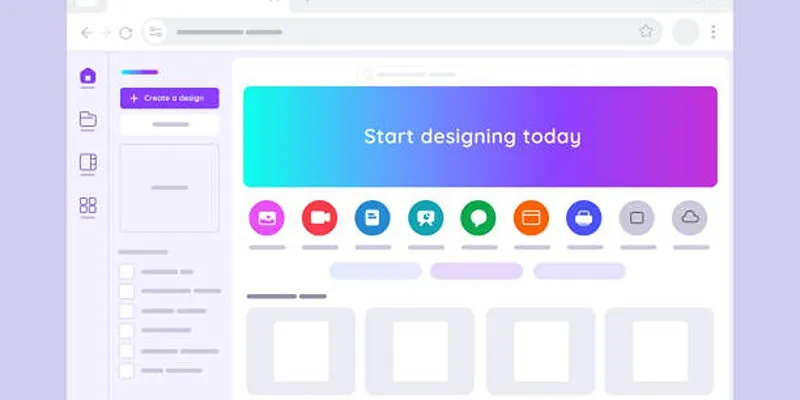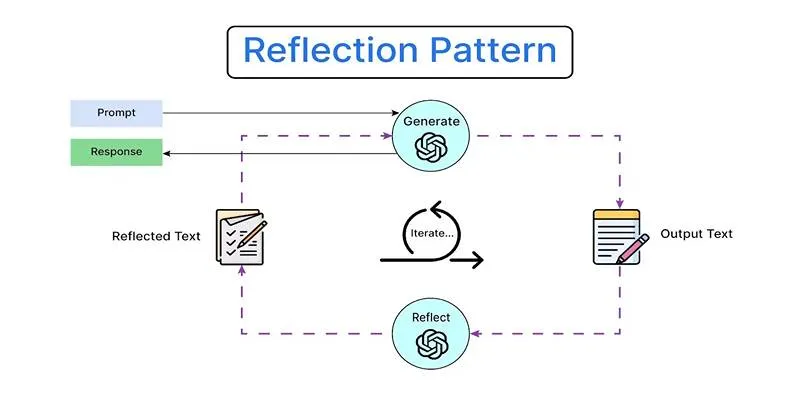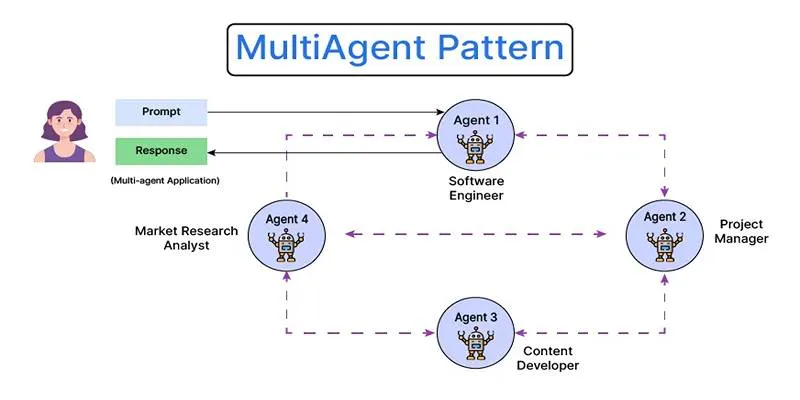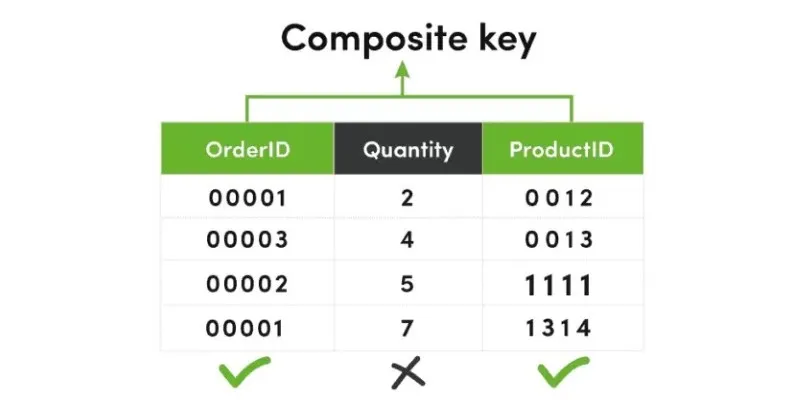Enhancing Agentic AI Systems: A Guide to Design Patterns
In today’s rapidly evolving digital landscape, Artificial Intelligence (AI) systems are progressing from simple response engines to sophisticated problem-solvers that emulate human reasoning. It’s no longer sufficient for AI models to generate text or code in a single instance; they must continuously analyze, adapt, and collaborate to achieve their objectives.
This evolution is encapsulated in the concept of Agentic AI, where large language models (LLMs) function as intelligent agents. These agents operate through iterative processes—reflecting on their output, integrating external resources, strategically planning their actions, and even collaborating—to deliver superior results.
Agentic AI design patterns provide the structural blueprints necessary for architecting these systems. They define how AI can transition from a simple one-shot prompt to a multi-stage, self-improving workflow that solves complex tasks with minimal human intervention. This post explores the top 4 design patterns that are foundational for developing autonomous AI systems.
What Are Agentic AI Design Patterns?
Agentic AI design patterns outline methods for transforming raw AI outputs into refined solutions. Rather than expecting a language model to deliver a perfect response on its first attempt, these patterns enable iterative improvement.
This process mirrors human problem-solving, where drafts are continuously evaluated and revised until the desired quality is attained. By structuring AI behavior in a step-by-step manner, these patterns empower systems to tackle tasks ranging from creative content generation to intricate problem-solving.
Key Characteristics of Agentic Design Patterns:
- Step-by-step reasoning instead of single-step generation
- Evaluation and revision of previous outputs
- Integration with external tools for data access and computation
- Structured decision-making processes
- Collaboration between multiple AI agents or components
These design patterns do not rely solely on the size or raw power of an AI model. Instead, they focus on creating workflows that enhance decision-making through iterative refinement, resource integration, careful planning, and cooperative processing.
1. The Reflection Pattern
The first design pattern, known as the Reflection Pattern, emphasizes self-evaluation. With this approach, an AI agent does not settle for its initial output; it reviews its work, identifies inconsistencies or errors, and modifies its response accordingly. This method involves an internal loop where the model “reflects” on the quality of its generated content.
Core Functions:
- Performs self-assessment of outputs
- Identifies issues in coherence, logic, or correctness
- Refines responses based on iterative critiques
- Continues improving until a high-quality outcome is achieved
This internal feedback mechanism is crucial in domains where precision is mandatory. The iterative nature of the Reflection Pattern leads to better quality, enhanced factual accuracy, and improved user satisfaction.
2. The Tool Use Pattern

The second agentic design pattern is the Tool Use Pattern. This pattern extends the model’s capabilities by allowing it to access external resources and tools to supplement its internal knowledge. By integrating with external tools—such as web search APIs, computational engines, or databases—the AI system is no longer confined to the data it was initially trained on.
This Pattern Enables AI Systems to:
- Query live databases or APIs
- Perform dynamic computations or logical operations
- Use third-party tools for enhanced processing
- Bring external context into their responses in real time
Through the Tool Use Pattern, an AI agent can dynamically retrieve current and relevant information, conduct complex computations, or even generate new data based on external input. It transforms the AI into an interactive system, not just a passive generator of information.
3. The Planning Pattern
The third design pattern is the Planning Pattern, a framework that empowers AI systems to approach problems in a structured and deliberate manner. When faced with a complex task, the Planning Pattern compels the model to organize the task into a sequence of smaller, manageable steps.
Planning Typically Includes:
- Defining the overall goal or objective
- Breaking down the task into logical steps or modules
- Executing steps in an organized sequence
- Adjusting the plan dynamically when new input or changes occur
Planning promotes foresight, structure, and traceability—critical qualities for any system operating in uncertain or evolving conditions. It also reduces the risk of logical fallacies or inconsistencies by focusing on one step at a time, all while keeping the end goal in sight.
Variants such as ReAct (Reasoning and Acting) and ReWOO (Reasoning With Open Ontology) enhance this pattern further, allowing models to interleave action and reasoning or incorporate domain-specific knowledge structures.
4. The Multi-Agent Pattern
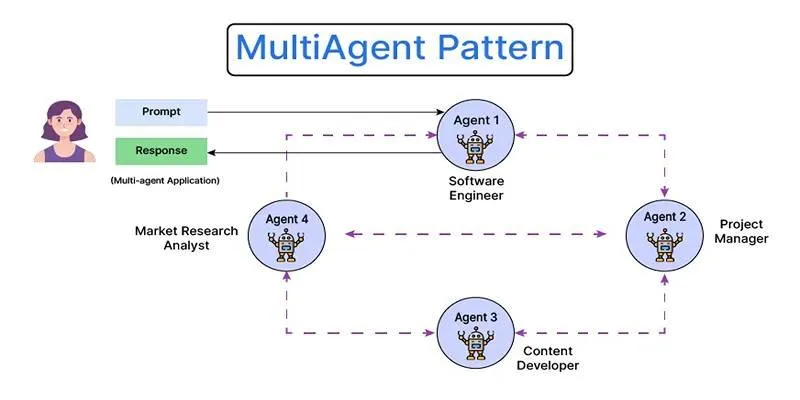
The fourth and final design pattern is the Multi-Agent Pattern, which emphasizes the benefits of collaboration and specialization. In a multi-agent system, several individual agents, each with specific areas of expertise, work together to achieve a common objective. This division of labor mirrors how humans function in collaborative environments—leveraging specialization to work more effectively.
The Pattern Supports Several Configurations:
- Collaborative agents: Each focuses on a different task but shares context
- Supervised agents: A central controller coordinates and monitors others
- Hierarchical agents: Tasks are distributed across layers with feedback loops
Each agent can operate independently or in communication with others, solving subproblems that contribute to the final solution. It not only improves scalability and flexibility but also allows systems to handle more complex workflows that would overwhelm a single agent.
Coordination is key in multi-agent design. Agents must be able to communicate goals, share information, and synthesize outputs without redundancy or conflict. When well-executed, this pattern delivers highly modular and efficient AI solutions that are adaptive and robust.
Conclusion
Agentic AI design patterns are redefining how we approach AI system architecture. By enabling language models to reflect, plan, use tools, and collaborate, we make them more autonomous, adaptive, and effective in real-world scenarios. These patterns move AI beyond static responses toward intelligent action. As we continue to integrate these patterns into modern AI workflows, systems will become more capable of handling complexity with minimal human oversight. This shift empowers developers to build more reliable, context-aware, and future-ready applications.
 zfn9
zfn9
